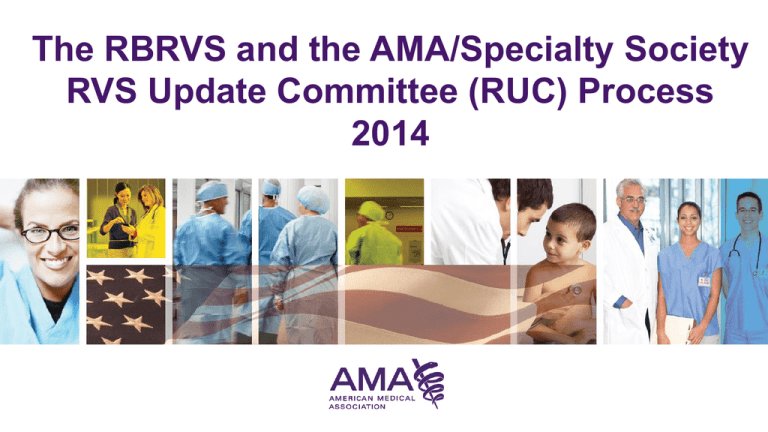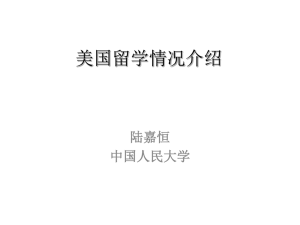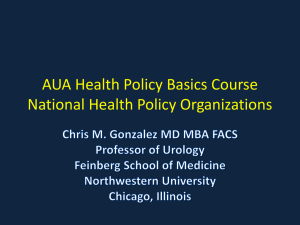Background on the RUC Process
advertisement

The RBRVS and the AMA/Specialty Society RVS Update Committee (RUC) Process 2014 Medicare RBRVS • Medicare implemented the Resource-Based Relative Value Scale (RBRVS) on January 1, 1992 • Standardized physician payment schedule where payments for services are determined by the resource costs needed to provide them • Most public and private payors utilize the Medicare RBRVS 2 Medicare RBRVS • The cost of providing each service is divided into three components 1. Physician Work 2. Practice Expense 3. Professional Liability Insurance 3 Physician or Qualified Health Care Professional Work • Determined by: – – – – The time it takes to perform the service The technical skill and physical effort The required mental effort and judgment Stress due to the potential risk to the patient 4 Practice Expense • Initially formed using average Medicare approved charges from 1991 and a proportion of each specialty's revenues that is attributable to practice expenses • In 1999, CMS transitioned to a resource-based practice expense relative value for each CPT code that differs based on the site of service • By 2002, the resource-based practice expenses were fully transitioned 5 Professional Liability Insurance • In 2000, CMS implemented the resource-based professional liability insurance (PLI) relative value units 6 Components of the RBRVS Percent of Total Relative Value Professional Liability Insurance, 4.3% Practice Expense, 44.8% Physician Work, 50.9% Medicare RBRVS • Payments are calculated by multiplying the combined costs of a services by a conversion factor (a monetary amount that is determined by the Centers for Medicare and Medicaid Services) • Payments are also adjusted for geographical differences in resource costs (geographic practice cost index (GPCI)) 8 Calculating Payment • The formula for calculating payment schedule amounts entails adjusting RVUs, which correspond to services, by the budget neutrality work adjustor and by the GPCIs, which correspond to payment localities. 9 Calculating Payment • The general formula for calculating Medicare payment amounts for January 1- December 31, 2014 is expressed as: – Total RVU = – [(work RVU x work GPCI) – + (practice expense RVU x practice expense GPCI) – + (malpractice RVU x malpractice GPCI)] – Total RVU x Conversion Factor* = Medicare Payment *The Conversion Factor for CY 2014 = $35.8228 10 Medicare’s Payment System for Physician Services • Since the introduction of RBRVS, changes have included: – Annual updates for new or revised CPT® codes – Four Five-Year Reviews of work values – 1997, 2002, 2007 & 2012 – Resource-Based Practice Expense RVUs – 1999 – Resource-Based PLI RVUs – 2000 11 AMA/Specialty Society Relative Value Scale Update Committee (RUC) • The RUC is an independent group of volunteer physicians exercising its First Amendment Right to petition the federal government. • The RUC is comprised of 31 members, 28 voting members (16 of these 28 voting members are from specialties whose Medicare allowed charges are primarily derived from the provision of E/M services). • The RUC is an expert panel. Individuals exercise their independent judgment and are not advocates for their specialty. 12 RUC Composition American Medical Association, CPT Editorial Panel, American Osteopathic Association, Practice Expense Subcommittee, Health Care Professionals Advisory Committee • • • • • • • • Anesthesiology Cardiology Dermatology Emergency Medicine Family Medicine General Surgery Geriatric Medicine Hematology/Oncology* • * indicates rotating seat Internal Medicine Neurology Neurosurgery Nephrology* Obstetrics/Gynecology Ophthalmology Orthopaedic Surgery Otolaryngology Pathology Pediatrics Pediatric Surgery* Plastic Surgery Primary Care* Psychiatry Radiology Thoracic Surgery Urology 13 RUC Cycle and Methodology • RUC’s cycle for developing recommendations is closely coordinated with both CPT’s schedule for annual code revisions and CMS’s schedule for annual updates in the Medicare Payment Schedule • CPT meets three times a year to consider coding changes for the next year’s edition • CMS publishes the annual update to the Medicare RVS in the Federal Register every year • These codes and relative values go into effect annually on January 1 14 RUC Cycle CPT Editorial Panel or CMS Level of Interest Requests Medicare Payment Schedule Survey Specialty RVS Committee CMS The RUC 15 RUC Cycle • Step 1: CPT’s new and revised codes and CMS requests to review existing codes are submitted to the RUC staff • Step 2: Members of the RUC Advisory Committee review and indicate their societies’ level of interest on developing a relative value recommendation • Step 3: AMA staff distribute survey instruments for the specialty societies to evaluate the work involved in the new or revised code 16 RUC Cycle • Step 4: The specialty RVS committees conduct the surveys, review the results and prepare their recommendations to the RUC • Step 5: The specialty advisors present the recommendations at the RUC meeting • Step 6: The RUC may decide to adopt a specialty society’s recommendation, refer it back to the specialty society or modify it before submitting it to CMS • Step 7: The RUC’s recommendations are forwarded to CMS in May of each year 17 Confidentiality • All RUC materials are confidential and for RUC use only • Cannot publish RVU recommendations until CMS publishes Federal Register 18 CPT 1993 - 2014 RUC Recommendations • Over 5,000 RUC recommendations for new and revised codes • Over 350 RUC recommendations for carrier priced or non-covered services • 1118 RUC recommendations during the First Five-Year Review • 870 RUC recommendations during the Second Five-Year Review • 751 RUC recommendations during Third Five-Year Review • 290 RUC recommendations during the Fourth Five-Year Review 19 CPT 1993 - 2014 RUC Recommendations • CMS/Carrier Medical Director review • Implementation of “interim” values by Medicare carriers with 60-day Comment period • CMS’s acceptance rate typically more than 90% annually 20 RUC Advisory Committee • One physician representative is appointed from each of the 122 specialty societies seated in the AMA House of Delegates • Advisory Committee members assist in the development of RVUs and present their specialties’ recommendations to the RUC • Each member comments on recommendations made by other specialties • Advisory Committee members are supported by an internal specialty RVS committee 21 Health Care Professionals Advisory Committee (HCPAC) Composition • • • • • • Audiologists Chiropractors Dieticians Nurses Occupational Therapists Optometrists • • • • • • Physical Therapists Physician Assistants Podiatrists Psychologists Social Workers Speech Pathologists 22 HCPAC • Purpose: To allow for the participation of limited license practitioners and allied health professionals in the RUC process • The professionals represented on the HCPAC use CPT to report the services they provide independently to Medicare patients, and they are paid for these services based on the RBRVS physician payment schedule • The HCPAC recommendations are sent directly to CMS 23 RUC Practice Expense Activities • The RUC submits recommendations to CMS on practice expense inputs for new and revised codes • The Practice Expense Advisory Committee (PEAC), (1999-2004) was responsible for reviewing existing practice expense data • The PEAC reviewed and made recommendations on almost 6,500 codes from a variety of specialties • The RUC Practice Expense Subcommittee continues to review and make recommendations on practice expense inputs (clinical labor, medical supplies and equipment) 24 RUC Subcommittees and Workgroups • Administrative Subcommittee – primarily charged with the maintenance of the RUC’s procedural issues • Relativity Assessment Workgroup – oversees the process of identification of potentially misvalued services • Multi-Specialty Points of Comparison (MPC) Workgroup – charged with maintaining the list of codes, which is used to compare relativity of codes under review to existing relative values 25 RUC Subcommittees and Workgroups • Practice Expense Subcommittee – reviews direct practice expenses (clinical staff, medical supplies, medical equipment) for individual services and examines the many broad and methodological issues relating to the development of practice expense relative values • Professional Liability Insurance (PLI) Workgroup – reviews and suggests refinements to Medicare’s PLI relative value methodology • Research Subcommittee – primarily charged with development and refinement of RUC methodology 26 The RBRVS Five-Year Review • Omnibus Budget Reconciliation Act of 1990 requires CMS to review all relative values at least every five-years and make any needed adjustments • Five-Year Review results implemented on January 1, 1997 and every five years thereafter 27 First Five-Year Review of the RBRVS • Corrected anomalies in work values for codes Example: Gynecologic procedures to equate urology procedures • Improvements to Evaluation and Management work relative values • Updated RBRVS to reflect increased work for certain procedures since the inception of RBRVS 28 Second Five-Year Review of the RBRVS • Unprecedented opportunity to improve the accuracy of the physician work component • The RUC submitted recommendations on 870 individual CPT codes to CMS • On November 1, 2001, CMS published a Final Rule in the Federal Register with refined work relative value units. CMS accepted 98% of the RUC’s recommendations. The relative value changes were implemented on January 1, 2002 29 Third Five-Year Review of the RBRVS Evaluation and Management Services • 27 specialties presented a consensus comment letter to CMS stating that the work of E/M services had changed significantly since the first Five-Year Review in 1995 • The societies also concluded that they believed E/M services were not appropriately valued because: – the intensity, complexity, and duration of intra-service medical care had increased in the past ten years; – the intensity, complexity, and duration of the pre- and post-service time had expanded; and – the work per unit of time for E/M services is less than the work per unit of time for almost any other service 30 Third Five-Year Review of the RBRVS Evaluation and Management Services • This Five-Year Review included 35 E/M services • The RUC submitted formal recommendations to CMS for: – increases in work RVUs for 28 E/M services – maintaining the work RVUs for 7 E/M services • In the June 2006 Proposed Rule, CMS has indicated that it will accept 100% of the RUC’s recommendations for E/M services 31 Third Five-Year Review of the RBRVS • The RUC submitted formal recommendations for 751 identified codes to CMS in October 2005, February 2006, March 2007 and May 2007 • CMS published a Proposed Rule in June 2006 regarding their consideration of the public comments and the RUC recommendations • After a comment period, CMS published the final work relative values in the November 2006 Final Rule • New work relative value recommendations resulting from this third Five-Year Review of the RBRVS were effective January 1, 2007 32 Creation of the Relativity Assessment Workgroup • In its March 2006 Report to Congress, the Medicare Payment Advisory Commission (MedPAC) commented that the RUC’s FiveYear Review process leads to substantially more increases in work RVUs than decreases. • MedPAC expressed concerns about the RUC’s ability to identify overvalued physician services. 33 Creation of the Relativity Assessment Workgroup • MedPAC recommended the establishment of a separate standing panel of medical economic experts to identify overvalued services. • MedPAC suggested that the new panel could identify overvalued services through various statistical analyses. 34 Creation of the Relativity Assessment Workgroup • Though no action was taken by the Congress, MedPAC reiterated these comments and recommendations in subsequent reports to Congress in 2007 and 2008. • MedPAC also expressed an opinion that the growth in volume of services might be evidence of misvaluation. 35 Creation of the Relativity Assessment Workgroup • The RUC maintained that it has the requisite expertise in identifying appropriate valuation and has a history of doing so. – Prior to the MedPAC recommendations, the RUC recommended reducing the RVUs for nearly 400 services (1992 – 1997). • The RUC established its Relativity Assessment Workgroup (initially called the Five-Year Review Identification Workgroup) in October 2006. 36 Mandate of the Workgroup • The purpose of the Relativity Assessment Workgroup is to develop and maintain processes associated with the identification and reconsideration of the value of “new technology” services. (Approved by the RUC October 2006) • The identification and review of potentially misvalued services will be conducted on an ongoing basis, rather than at the upcoming FiveYear Review. (Approved by the RUC February 2008) 37 Screening Mechanisms for Potentially Misvalued Services – – – – – Bundled CPT Services CMS Fastest Growing Procedures CMS High Expenditure Procedural Codes CMS/Other Source Codes Harvard Valued (Utilization Over 30,000 and Medicare Allowed Charges >$10 million) – High Intra-service Work Per Unit of Time (IWPUT) – High Volume Growth – Low Value/Billed in Multiple Units 38 Screening Mechanisms for Potentially Misvalued Services – – – – – – – – – Low Value/High Volume MPC (Multi-Specialty Points of Comparison)List Pre-Time Analysis Post-Operative Visits Services Surveyed by One Specialty – Now Performed by a Different Specialty Services with Stand-Alone PE Procedure Time Site of Service Anomalies 010-day and 090-day Global Period Anomalies New Technology 39 The Process of Review • The Workgroup develops an objective criterion (also called a “screen”) for identification of potential misvaluation. • The Workgroup recommends the criterion to the RUC for approval. • The Workgroup applies the screen to the universe of physician services and generates a list of codes meeting the screen. 40 The Process of Review • The codes identified by a screen are forwarded to all specialty societies before a RUC meeting in a “level of interest” process. • Specialties are asked to develop work-plans to either explain why the service is appropriately valued despite meeting the screen criteria or, if there is no clinical explanation, a plan to address the aberration. 41 The Process of Review • Codes that have no clinical explanation for appearing on the screen may be addressed through: – Referral to CPT where the descriptor is ambiguous and results in incorrect reporting. – If a change in the descriptor is not necessary, referral to CPT Assistant to develop education to promote appropriate reporting. – Survey and re-valuation of physician work or practice expense, where the service is potentially misvalued. 42 The Process of Review • The Workgroup reviews the comments of the specialty society and makes a recommendation to the RUC. • The RUC, then refers the service to CPT or recommends that the service be surveyed after solicitation from CMS. • CMS then approves/requests review of valuation for existing CPT codes. 43 Summary of Recommendations to Date • Since the inception of the Relativity Assessment Workgroup, the RUC and CMS have identified 1,701 services through its screening criteria for further review by the RUC. 44 Summary of Recommendations to Date • • • • RUC Review Complete = 1,705 Referred to CPT = 57 RUC to Review Sept 2014 = 28 Future Review after additional data obtained = 77 45 Potentially Misvalued Services Project 9% 28% 15% Codes Under Review, 162, 9% Deleted, 250, 15% Decreased, 685, 40% 8% 40% Increased, 131, 8% Reaffirmed, 477, 28% 46 More Information Department of Physician Payment Policy & Systems AMA Plaza 300 N. Wabash Street Chicago, Illinois 60611 (312) 464-4736 Phone RUC.Staff@ama-assn.org www.ama-assn.org/go/rbrvs 47







